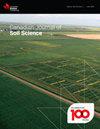Soil quality index under different land-use types: the case of Choke Mountain agroecosystems, upper Blue Nile Basin, Ethiopia
IF 1.5
4区 农林科学
Q4 SOIL SCIENCE
引用次数: 1
Abstract
Abstract In an agroecosystem (AES), land-use types affect soil quality. As a result, determining soil quality in various land uses is critical. This study was carried out to evaluate the soil quality index (SQI) of the different land-use types in AESs of the Choke Mountain watershed, upper Blue Nile Basin. Forty-seven soil samples were taken from cultivated land (CL), grazing land (GL), plantation forest land (PFL), and natural forest land (NFL) of the five AESs. The minimum data set (MDS) was chosen using principal component analysis. To calculate SQI, five soil quality indicators were selected as an MDS: silt, pH, cation exchange capacity, exchangeable potassium, and soil organic matter. SQIs for the overall land uses were ordered as GL > NFL > PFL > CL. Compared with NFL, the SQIs of PFL and CL were reduced by 10% and 19.7%, respectively, whereas the SQI of GL was increased by 1.8%. Among AESs of Choke, SQI of GL was higher in the midland plain, dominated by Vertisol (AES 2), followed by the midland plain with Nitosols (AES 3). SQI of CL was intermediate, and SQIs of GL, NFL, and PFL were good. AES 2 of the watershed recorded the highest total SQI value, whereas hilly and mountainous highlands (AES 5) recorded the lowest SQIs compared to other AESs. Thus, site-specific land use and management practices across the various AESs should be recommended to policymakers and farmers for a sustainable ecosystem and environment.不同土地利用类型下的土壤质量指数——以埃塞俄比亚青尼罗上游呛山农业生态系统为例
在农业生态系统(AES)中,土地利用类型影响土壤质量。因此,确定不同土地用途的土壤质量至关重要。以青尼罗上游呛山流域AESs不同土地利用类型的土壤质量指数(SQI)为研究对象。从5个农业生态系统的耕地(CL)、放牧地(GL)、人工林(PFL)和天然林(NFL)采集土壤样品47份。采用主成分分析法选取最小数据集。为了计算SQI,选取淤泥、pH、阳离子交换容量、交换性钾和土壤有机质5个土壤质量指标作为MDS。整体土地用途的sqi排序为GL > NFL > PFL > CL。与NFL相比,PFL和CL的SQI分别降低了10%和19.7%,而GL的SQI增加了1.8%。在窒息的AESs中,中部平原地区GL的SQI较高,以Vertisol (AES 2)为主,其次是中部平原地区的Nitosols (AES 3)。CL的SQI为中等,GL、NFL和PFL的SQIs较好。流域的空气质量指数(AES 2)最高,而丘陵和山地高原(AES 5)的空气质量指数最低。因此,应向决策者和农民推荐不同农业生态系统的具体土地利用和管理实践,以实现可持续的生态系统和环境。
本文章由计算机程序翻译,如有差异,请以英文原文为准。
求助全文
约1分钟内获得全文
求助全文
来源期刊

Canadian Journal of Soil Science
农林科学-土壤科学
CiteScore
2.90
自引率
11.80%
发文量
73
审稿时长
6.0 months
期刊介绍:
The Canadian Journal of Soil Science is an international peer-reviewed journal published in cooperation with the Canadian Society of Soil Science. The journal publishes original research on the use, management, structure and development of soils and draws from the disciplines of soil science, agrometeorology, ecology, agricultural engineering, environmental science, hydrology, forestry, geology, geography and climatology. Research is published in a number of topic sections including: agrometeorology; ecology, biological processes and plant interactions; composition and chemical processes; physical processes and interfaces; genesis, landscape processes and relationships; contamination and environmental stewardship; and management for agricultural, forestry and urban uses.
 求助内容:
求助内容: 应助结果提醒方式:
应助结果提醒方式:


